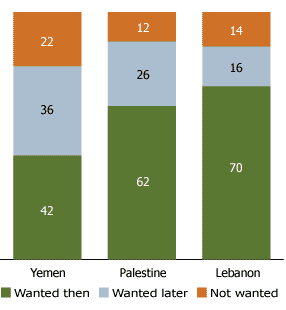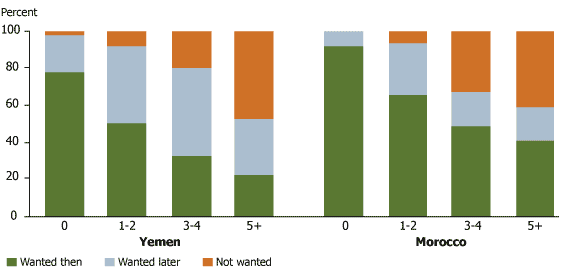
Unintended Pregnancies in the Middle East and North Africa
This article was originally prepared for a presentation at the IUSSP International Population Conference in Marrakech, Morocco, in October 2009.
(November 2009) Unintended pregnancies are widespread in the Middle East and North Africa (MENA).1 Unintended pregnancies are a burden on women’s health and their families, as well as on countries’ health systems and social and economic development. Although the challenge of unintended pregnancies may appear to be a private concern for women and their families, the health and demographic consequences require a public policy response for both individuals’ and societies’ well-being.
Women, families, and societies benefit when childbearing is planned. But too often, women become pregnant when they do not wish to have more children or wish to have a child much later. Whether and when to have a child is a basic human and reproductive right acknowledged in international agreements, including the Programme of Action of the UN International Conference on Population and Development held in Cairo in 1994.
It is particularly urgent to address the issue of unintended pregnancy in the MENA region because an unprecedented number of women are in the reproductive age group (ages 15 to 49) and at risk of an unintended pregnancy. The UN estimates that the number of women of reproductive age in the MENA region will exceed 120 million in 2010, with more than half between the ages of 15 and 29.
A New Analysis of Pan Arab Population and Family Health Surveys
A new analysis presented at the IUSSP Conference in Marrakech shows that unintended pregnancies in the MENA region are widespread across countries and across socioeconomic groups within countries. The analysis includes countries where a Pan Arab Population and Family Health (PAPFAM) survey has recently been conducted: Algeria (2002); Lebanon and Morocco (2004); Palestine (referring to the population of Gaza and the West Bank, including East Jerusalem, 2006); Syria (2001); and Yemen (2003). These nationally representative surveys provide comparable data on population, family planning, and maternal and child health, and asked married pregnant women about their attitudes toward their pregnancy: “At the time you became pregnant, did you want to become pregnant then, did you want to wait until later, or did you not want to become pregnant at all?”2
Figure 1
Distribution of Women by Attitude Toward Their Pregnancy

Source: PAPFAM surveys.
New Findings
The PAPFAM surveys show that one in three pregnancies in the region is unintended and that pregnant women generally tend to report their pregnancies as unintended at a higher rate in countries where the overall fertility level is higher. In Yemen, where women on average give birth to six children, only 42 percent of pregnant women wanted to have the pregnancy “then,” as compared with 70 percent in Lebanon where women on average give birth to two children (see Figure 1). In other words, pregnant Yemeni women were less likely to want their pregnancies “then” than their counterparts in the other countries—58 percent of pregnant Yemenis either wanted no more children or wanted a child later. These rates translate into an estimated half a million births in the country in 2009 that can be labeled as “unintended.”
The study shows not only that unintended pregnancies are widespread across the MENA region, but also widespread across individual countries. In each country in the study, the percentage of pregnant women living in urban areas who reported their pregnancy as unintended was similar to that of pregnant women living in rural areas. Women with higher education levels were generally less likely to report their pregnancies as unintended.
Since marriage is a legal and cultural prerequisite for childbearing in the MENA region, any study of unintended pregnancies in the region should look at marriage patterns. Among the PAPFAM countries, the percentage of women ages 15 to 49 who were married at the time of the survey ranged from 42 percent in Algeria and 45 percent in Lebanon to 57 percent in Palestine and 59 percent in Yemen. Yemeni women are three times more likely to be pregnant than Lebanese women because they are more likely to be married and more likely to be pregnant when they are married.
As expected, pregnant women with higher numbers of children tend to report their pregnancy as unintended at a higher rate. The percentage of women who said that they did not want to have their pregnancy at all increases as the number of children they have increases (see Figure 2). In Morocco, for example, 33 percent of pregnant women who already had three or four children said they did not want the pregnancy at all, compared with 6 percent of those who had one or two children. In Yemen, one in 10 married women who had given birth to at least five children were pregnant, and three quarters of them said they did not want that pregnancy; with nearly half of them saying that they did not want it at all.
Figure 2
Pregnant Women by Number of Children and Attitude Toward Their Pregnancy

Source: PAPFAM surveys.
The high rate of unintended pregnancies in the MENA region is a serious public health issue that impedes governments’ efforts to improve women’s and children’s health. International studies have shown that when a pregnancy is not intended at the time of birth, it jeopardizes the health of both the mother and child. Unintended pregnancies carry a higher risk of maternal mortality and morbidity because they are associated with unsafe abortions, and a higher risk of child illness because of late initiation and underuse of prenatal care, poor health behaviors during pregnancy, complications during delivery, low birth weight, and problems in child development.
By reducing unintended pregnancy, MENA governments not only help improve the health and well-being of women and their families, but also help their countries achieve their development goals.
Farzaneh Roudi is program director, MENA, at the Population Reference Bureau. Ahmed Abdul Monem is director of the Pan Arab Project for Family Health.
References
- Countries included in the Middle East and North Africa (MENA) region as defined here include: Algeria, Bahrain, Egypt, Iran, Iraq, Jordan, Kuwait, Lebanon, Libya, Morocco, Oman, and Palestine.
- Pan Arab Project for Family Health, The Arab Family Health Survey, Module “A” Core Questionnaires (Cairo: Pan Arab Project for Family Health, 2001).
